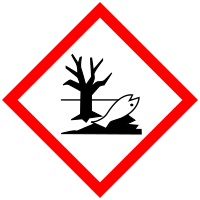
Improving Member States preparedness to face an HNS pollution of the Marine System (HNS-MS)
1,2,3-Trichlorobenzene
Description Top
| CAS number | 87-61-6 |
| UN number | 2810 |
| Chemical formula | C6H3Cl3 |
| Standard European Behaviour Classification (SEBC) | Sinker (S) |
GESAMP Hazard profile
| A1 | A2 | B1 | B2 | C1 | C2 | C3 | D1 | D2 | D3 | E1 | E2 | E3 |
| 4 | NR | 4 | 2 | 1 | 0 | 2 | 2 | 2 | NI | S | 2 |
Marine pollution Classification (MARPOL Annex II)
| Category | Description |
| X | Noxious Liquid Substances which, if discharged into the sea from tank cleaning or deballasting operations, are deemed to present a major hazard to either marine resources or human health and, therefore, justify the prohibition of the discharge into the marine environment. |
Alternate names for this chemical
1,2,6-Trichlorobenzene
Vic-Trichlorobenzene
1,2,3-Tcb
1,2,3-Trcb
1,2,3-Trichlorobenzene
Trichloro-1,2,3 Benzene
Vic-Trichlorobenzene
1,2,3-Tcb
1,2,3-Trcb
1,2,3-Trichlorobenzene
Trichloro-1,2,3 Benzene
Physico-chemical properties Top
| Chemical formula | C6H3Cl3 | |
| Molar mass | 181.46 [g/mol] | |
| State | Solid at 25°C and 1 atm | |
| Fusion temperature | 51.3 [°C] | |
| Boiling temperature | 218.5 [°C] | |
| Critical temperature | 762.5 [°C] | |
| Density |
|
|
| Kinematic viscosity |
|
|
| Hydrosolubility |
|
|
| Vapour pressure |
|
|
| Critical pressure | 3010000 [Pa] | |
| Vapour density | 6.26 | |
| Flash point (Pensky-Martens closed cup) | 113 [°C] | |
| Henry's constant | 126.7 [mol/(m³·Pa)] |
Behaviour Top
| Log Kow | 4.05 |
| Log Koc | 3.14 |
| Hydrolysis (Half-life) | Not hydrolysable |
| Aqueous photolysis (Half-life) | Not photolysable |
| Standard European Behaviour Classification (SEBC) | Sinker (S) |
| Bioconcentration factor (BCF) | 1300 |
Ecotoxicity Top
| Lowest median lethal concentration (LC50) on crustacean | 0.08 [mg/l] |
| Lowest median lethal concentration (LC50) on fishes | 0.348 [mg/l] |
| Highest no observed effect concentration (NOEC) on fishes | 0.9 [mg/l] |
Hazards Top


Warning
Hazards statements
Health
H317
May cause an allergic skin reaction.
Environmental
H410
Very toxic to aquatic life with long lasting effects.
Precautionary statements
Prevention
P262
Do not get in eyes, on skin, or on clothing.
P273
Avoid release to the environment.
P280
Wear protective gloves/protective clothing/eye protection/face protection.
GESAMP Top
GESAMP Hazard profile
| A1 | A2 | B1 | B2 | C1 | C2 | C3 | D1 | D2 | D3 | E1 | E2 | E3 |
| 4 | NR | 4 | 2 | 1 | 0 | 2 | 2 | 2 | NI | S | 2 |
A1: Bioaccumulation
| Rating | Description |
| 4 | High potential to bioaccumulate |
A1a:
| Rating | Description | Criteria [mg/l] |
| 4 | High potential to bioaccumulate | 4 ≤ Log Kow < 5 |
A1b:
| Rating | Description | Criteria |
| 4 | High potential to bioaccumulate | 500 ≤ BCF < 4000 |
A2: Biodegradation
| Rating | Description |
| NR | Not readily biodegradable |
B1: Acute aquatic toxicity
| Rating | Description | Criteria [mg/l] |
| 4 | Highly toxic | 0.1 < LC/EC/IC50 ≤ 1 |
B2: Chronic aquatic toxicity
| Rating | Description | Criteria [mg/l] |
| 2 | Moderate | 0.01 < NOEC ≤ 0.1 |
C1: Acute oral toxicity
| Rating | Description | Criteria [mg/Kg] |
| 1 | Slight | 300 < AOTE ≤ 2000 |
C2: Acute dermal toxicity (skin contact)
| Rating | Description | Criteria [mg/Kg] |
| 0 | Negligible | ADTE > 2000 |
C3: Acute inhalation toxicity
| Rating | Description | Criteria [mg/l] (4 hours exposure) |
| 2 | Moderate | 2 < AITE ≤ 10 |
D1: Skin irritation or corrosion
| Rating | Description | Sign | GHS category |
| 2 | Irritating | Marked erythema, Obvio | Irritant Category 2 |
D2: Eye irritation
| Rating | Description | Sign | GHS category |
| 2 | Irritating | Marked conjunctival hy | Irritant Category 2A |
D3: Long-term health effects
| Notation | Hazard endpoint | Description | GHS category |
| No Information |
E1: Tainting of seafood
| Rating | Description |
| NI | No Information |
E2: Behaviour of chemicals in the marine environment
| Rating | Description |
| S | Sinker |
E3: Interference with the use of coastal amenities
| Rating | Interference | Description | Interpretation | Warning |
| 2 | Moderately objectionable | 1 is a persistent floater; and/or 2 is moderately acutely toxic; and/or 3 is irritating to skin and/or eyes; and/or 4 has long-term health effects other than carcinogenicity, mutagenicity or reprotoxicity; and/or 5 is highly flammable; and/or 6 is moderately flammable and is a floater with evaporative properties | 1 E2 = Fp; and/or 2 C1 and/or C2 and/or C3 = 23; and/or 3 D1 and/or D2 = 2; and/or 4 D3 contains Ss, Sr, T, A, N, or I; and/or 5 Flashpoint <23°C; and/or 6 Flashpoint 23°C to 60°C and E2 = FE or FED | Warning issued and possible closure of amenities |
GHS Security Information


Warning
About the project
HNS-MS is a decision-support tool that Belgian and French maritime authorities as well as coastguard stations can activate in order to forecast the drift, fate and behavior of acute marine pollution by Harmful Noxious Substances (HNS) accidentally released in the marine system.
Contact us
Copyright © 2015–2024 HNS-MS Consortium
 HNS-MS has been funded by DG-ECHO under agreement ECHO/SUB/2014/693705 and runs from 1 January 2015 to 31 March 2017.
HNS-MS has been funded by DG-ECHO under agreement ECHO/SUB/2014/693705 and runs from 1 January 2015 to 31 March 2017.